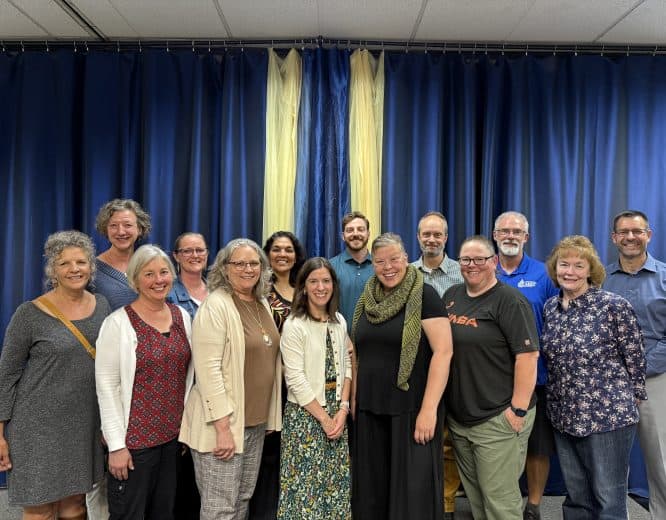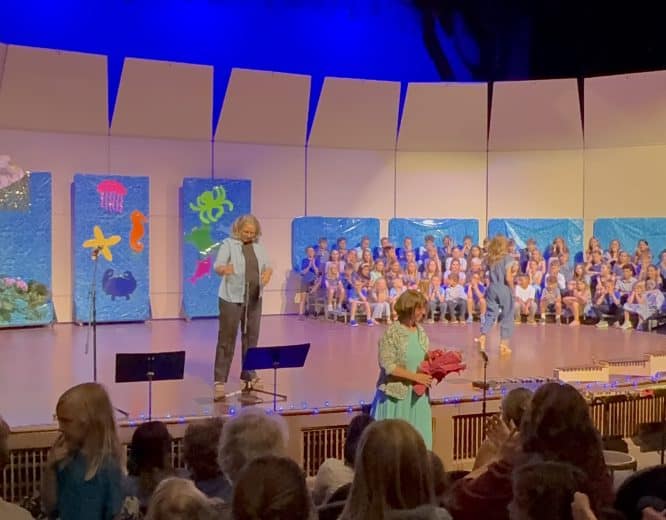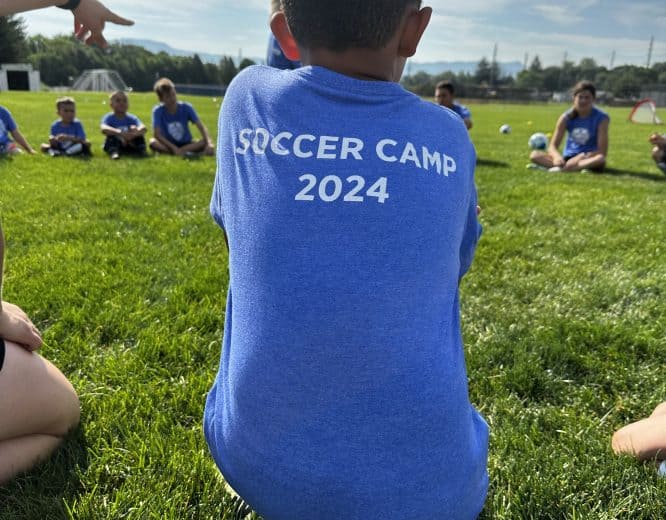EMS Students Earn College Credit With Robotics Classes
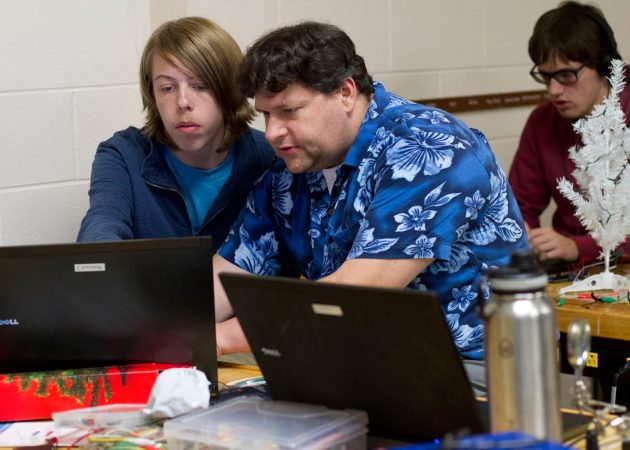
With Artificial Intelligence on the rise, Kevin Carini brings hands-on experience with robotics to Eastern Mennonite School, preparing students for the future.
“There’s going to be robots doing something in most households in the not-too-distant future,”he reflects. “Somebody needs to know how to code them and fix them. That’s really the future.”
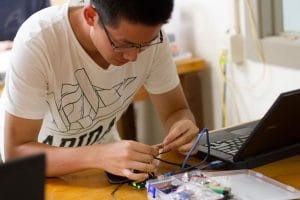
Mike Mi ’19 in Robotics II class at EMS.
In his second year with EMS, Carini teaches dual enrolled General Chemistry, dual enrolled Robotics I and II, and STEM exploration for 7th graders. He brings with him 13 years of experience teaching high school chemistry and physics, and four summer programs of robotics training through James Madison University (JMU) under the leadership of Nick Swayne and Dr. Joseph Enedy.
Thanks to new a partnership with JMU’s physics department, EMS students now have the opportunity to earn dual-enrolled credit for Carini’s robotics classes. While earning credit for Robotics I and II at the high school level, eligible students can also earn college credit for JMU’s ISCI-Robotics 101.
Swayne, member of Harrisonburg City Schools’ School board and Executive Director of Virginia-DC FIRST Lego League (FLL), has worked with Carini for 10 years. “I am always impressed by Kevin’s passion for teaching and learning and his ability to pull kids out of their comfort zone,” he said. “I know many of his students never imagined themselves doing robotics.”
“Few small private schools like EMS have the capacity to recruit someone of Kevin’s caliber to focus on his areas of expertise,” Swayne continued. “Your students are lucky.”
Three levels of Robotics study
Students have the opportunity to take three levels of robotics at EMS.
En el STEM exploratory course, 7th graders learn about electronics through hands-on experiences building circuits, programming Lego Robots, solar cars, and eventually creating model rockets to end the school year in a bang.
Robotics I introduces students to robot basics: circuits, design, building, and programming on arduino boards. By January, they complete a robot that can avoid obstacles, back up, and turn. By April, they build robot arms using 3D printers and servomotors, a rotary actuator that allows for precise control of angular positoin. The class’s final project uses Seaperch kits to build an underwater robot, which students will test at the JMU Recreation Center.
Robotics II builds on what students learn in the introductory class, expanding their application to build more complex robots, remote control cars, and microcontrollers.
“I really like learning how to code,” says Adam Stoltzfus ’20. “It’s like learning another language.” Stoltzfus built a robotic arm in Robotics II this fall (video above, robotic arm, built in Robotics II, fall 2018). “I hope to get into Virginia Tech and major in some sort of engineering,” he says. “This experience will help me to know more as I go into college.”
“Our Robotics I class starts for beginners,” Carini said. “They know nothing, I assume, or most of them don’t. By the time they get to January, they have built, programmed, and wired a robot that will move around and avoid obstacles.”
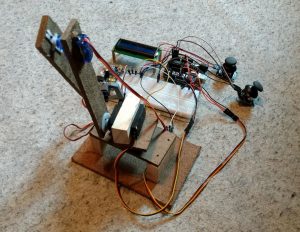
Lleyton Stutzman ’21 built these robotic arms
controlled with Arduinos, a circuit board that can be used to control motors, sensors, and more. “I constructed it with masonite, wood, a 3-D printed claw, and servo motors for the moving parts,” he says. “Overall I am happy with my end result, but the claw is too weak to pick up anything.”
Because both classes are project-based, Carini can teach Robotics I and II at the same time. This allows students to learn from their peers, which he says “helps to scaffold students to higher levels of understanding.” By observing their Robotics II classmates, beginner robotics students can see potential in their own growth and aspire to the same projects next year.
In October, Carini secured a $650 4-VA grant towards the purchase of two 3D Flash Ford Finder printers for the Robotics Makerspace. Part of the grant requires collaboration with the local Harrisonburg City Public Schools, which will give EMS and HCPS students new opportunities to learn through each school’s STEM activities.
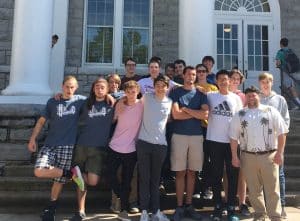
Kevin Carini, front right, took Robotics II students to JMU earlier this fall to visit their 3D printer lab.
The printers move the school’s STEM and Robotics initiative closer to a completed makerspace, something Carini says he is “super excited” to be a part of.
A makerspace is a collaborative work space inside a school, library or separate public/private facility for making, learning, exploring and sharing that uses high tech to no tech tools, according to makerspace.com. In educational settings, “a makerspace presents readily-available materials that can act as a provocation for inquiry, as well as modern technology and items” with which to invent.”
The 3D printers arrived at EMS on October 16. Students immediatley excitedly put them to work making their first tester cube.
Carini’s excitement in the classroom is contagious and students pick up on that enthusiasm, developing passion and desire to learn more about all the subjects he teachers. “The reason I do it is because I enjoy it. I just want to share my enthusiasm with my students,” Carini said.
“The passion and energy of our science teachers for their subjects is a school-wide trait of all of our teachers,” said Patsy Seitz, director of academics for EMS. “We know our students will experience academic excellence in all of our classrooms.”
Opportunities ahead
Upcoming opportunities for robotics students include attending lectures at JMU, FIRST Lego League (FLL) in December, and FIRST Technology Challenge (FTC) spring semester. Beginning in January, the FTC group will meet after school to work on completing this year’s mission: simulating a rover landing and mining on Mars.
“Last year we got dead last,” Carini said of the FTC competition, “but that’s okay for being rookies. The only way to go from here is up.”
Carini keeps looking up, hoping to introduce more STEM courses to EMS in the near future. New offerings would include Robotics III, Advanced Placement Computer Science, and a coding class for students to learn programming languages like Java.
He also wants to fully convert the shop classroom to a Makerspace and soldering area for robotic creations, as well as expanding robotics curriculum to the elementary school level, providing EMS students of all ages with creative spaces to engage technology.

